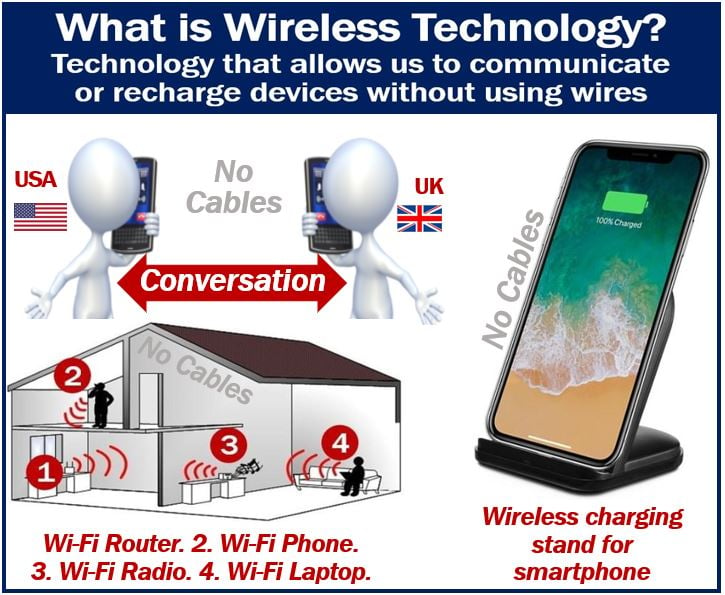Wireless Technology refers to technology that allows us to communicate without using cables or wires. According to www.techconsumerguide.com/, with this type of technology, people and other entities can communicate over very long distances. Wireless technology includes RF and IR waves. RF and IR stand for radio frequency and infrared respectively.
Wireless technology is a key driver of innovation in various sectors, including telecommunications, healthcare, and automation, by offering flexible and scalable solutions for data transmission.
The term ‘wireless’ first entered the English language at the end of the nineteenth century. At the time it meant “communication via radio waves rather than with cables or wires.”
The term may also refer to devices that draw power without using cables. In other words, a smartphone that we can recharge without wires has wireless technology in it. However, in most cases, the term refers to communicating without wires or cables.
This article focuses on the term when it refers to communicating without wires.
Wireless technology has come a long way over the past couple of decades. Who would have thought 50 years ago that employees could monitor activities at home with a wireless webcam?
Wireless technology – brief history
Wireless technologies in one form or another have been around for a long time. It all started with German physicist Heinrich Hertz (1857-1894) when he discovered electromagnetic waves.
-
The photophone
The first wireless conversation ever occurred in 1880 when Charles Sumner Tainter and Alexander Graham Bell invented the photophone. They also patented the photophone in that year. The photophone was a telephone that conducted audio conversation over modulated light beams.
Tainter (1854-1940) was an American scientific instrument maker, engineer, and inventor. Bell (1847-1922) was a Scottish-born scientist, inventor, engineer, and innovator.
-
Radio transmission and wireless telegraphy
Guglielmo Marconi (1874-1937), an Italian inventor and electrical engineer, pioneered work on long-distance radio transmission.
In 1909, Marconi and Karl Ferdinand Braun shared the Nobel Prize in Physics for the development of wireless telegraphy. Braun (1850-1918) was a German inventor and physicist.

-
The radio, TV, and satellites
During the 20th century, many types of wireless technologies emerged. The radio, which Marconi invented, and television, for example, receive broadcast communications without using wires. Satellites are also examples of wireless technology.
According to Encyclopedia.com:
“Wireless technology provides the ability to communicate between two or more entities over distances without the use of wires or cables of any sort. This includes communications using radio frequency (RF) as well as infrared (IR) waves.”
Wireless technology today
Most lay people today think of laptops, tablets, smartphones, and modems (routers) if you ask them about wireless technology.
The term has become part of our everyday vernacular. For most of us, there are currently two main types of wireless technology:
1. Local Wi-Fi networks
Wi-fi is a technology that allows tablets, video game consoles, projectors, printers, and smartphones to communicate with the Internet. Medical devices, laptops, and digital audio players also use Wi-Fi.
The term ‘Wi-Fi’ emerged in the 1990s from the words ‘Wireless’ plus ‘Fi,’ which was an arbitrary second element, after ‘Hi-Fi.’ People often mistakenly interpret the term as a short form of ‘Wireless Fidelity.’
2. Cellular networks (mobile phone networks)
This technology allows electronic devices to communicate over long distances. One person in, for example, Alaska, can talk to another person in Australia using their smartphones. Cellular networks allow them to do that.
Livewire.com says the following regarding the definition of the term: “Wireless’ is a broad term that encompasses all sorts of technologies and devices that transmit data over the air rather than over wires, including cellular communications, networking between computers with wireless adapters and wireless computer accessories.”
The advent of IoT, or the Internet of Things, has expanded the role of wireless technology in enabling devices to communicate and interact with each other autonomously, often creating smart, interconnected environments.
This integration has paved the way for advanced applications such as smart homes, where appliances can be controlled remotely, and smart cities, which utilize sensors to manage traffic and conserve energy efficiently.
Video – What is Wireless Technology?
This video, from our sister channel on YouTube – Marketing Business Network, explains what ‘Wireless Technology’ is using simple and easy-to-understand language and examples.
